Toto La Momposina's new album Oye Manita has been awarded "Top Of The World" in the latest issue of Songlines magazine. Click here to learn more about the album.
Catrin, Seckou and AMJ rock WOMAD 2014
 The Astar family were out in full force this week as WOMAD sold all 40,000 tickets for the first time at Charlton Park.
Catrin & Seckou played a blinder in the early hours of Saturday morning. Don't take our word for it... here is what the papers said.
The Astar family were out in full force this week as WOMAD sold all 40,000 tickets for the first time at Charlton Park.
Catrin & Seckou played a blinder in the early hours of Saturday morning. Don't take our word for it... here is what the papers said.
"Catrin Finch and Seckou Keita, a collaboration as delightful as it is unlikely. Finch, a Welsh harpist, was lined up a few years ago to play a tour with Malian kora player Toumani Diabaté, and warmed up by rehearsing with his Senegalese counterpart Keita. Diabaté eventually showed up mere hours before the first of those concerts, and though he was there for the tour, Finch felt a closer connection with Keita. They carried on working together and last year released an album of duets, Clychau Dibon, that proved a surprise hit.
Here, the blend of Manding and Welsh material finally stilled the buzz of chatter around the edge of the tent. They listened intently to each other, nodding and smiling as the songs took shape. They duelled playfully on “Future Strings”, Finch plucking ascending chords and running 47-string-long glissandi in a way that is hard for a kora to emulate, though Keita tried; when she knocked rhythms on the frame of her harp, his echo on the gourd of the kora was resonant and strong. The centrepiece of the set, as of the album, was “Robert Ap Huw Meets Nialing Sonko”: in the second half, when Finch took up the dancing Casamance pattern with her right hand, plucking the occasional bass string with her left, the whole tent held its breath." Financial Times
"Following Thompson after midnight was the mellifluous award-winning sound of the kora and harp of Seckou Keita and Catrin Finch, as gorgeous as it is on record" Independent
AMJ were also a huge success on the main stage with the Malmesbury schools' project. Their biggest gig yet and the Collective has expanded tenfold!
Dibon Telerama! 4F review
21/5/2014
Deux CD surprenants où la kora, la harpeluth des griots maliens, est élevée au rang d'instrument soliste.
Virtuose anobli notamment pour ses apartés magiques avec Ali Farka Touré, le Malien Toumani Diabaté fait partie de ces musiciens, qui ont contribué à faire de la kora, la harpe-luth des griots, un instrument soliste à part entière. Son propre père, le grand Sidiki Diabaté, fut pionnier du genre. Perpétuant cette science instrumentale avec son fils, le « petit » Sidiki, jeune prodige de 22 ans, star des scènes rap au Mali, dont on avait déjà entendu le panache et la vélocité. Symbole émouvant, leur huis clos familial (1) s'inscrit dans un certain classicisme. En ressuscitant de vieux morceaux oubliés, père et fils témoignent avant tout de l'intemporalité de leur tradition. Techniquement au sommet, plus volubiles qu'inventifs, ils se contentent de faire ruisseler à quatre mains l'ensorcelante geste mandingue. C'est déjà beaucoup...
On a connu Toumani Diabaté plus aventureux (ses foisonnantes Mandé Variations). Il a failli donner la réplique à la Galloise Catrin Finch sur le projet afro-celte de John Hollis. Les événements maliens ont freiné leur collaboration, et le Sénégalais Seckou Keita l'a remplacé. A travers l'entrelacs cristallin et onirique des cordes de la kora et de la harpe celtique, ce duo singulier explore sur Clychau Dibon (2) les points de convergence mélodiques et harmoniques entre deux cultures instrumentales multiséculaires. La richesse des arrangements (la harpe joue même les basses !) réinvente l'une et l'autre avec une grande fraîcheur. Tout le disque ne tient pas les promesses ambitieuses du premier titre, mélopée celte médiévale réveillée par un ostinato de kora. Mais le lyrisme transcende les compositions plus linéaires. Reproche éventuel à cette production anglaise : son parti pris esthétisant. La joliesse n'est pas un mal, mais plus de folie n'aurait pas nui. — Anne Berthod
1) Toumani & Sidiki, Toumani et Sidiki Diabaté, 1 CD World Circuit/Harmonia Mundi .
2) Clychau Dibon, Catrin Finch et Seckou Keita, 1 CD Astar-Mwldan/L'Autre distribution .
Catrin & Seckou: "delicate but quietly thrilling" Guardian ***** Review
5 stars out of 5
Robin Denselow
The Guardian, Friday 16 May 2014 15.29 BST
Bush Hall, London
This, I suspect, will be remembered as one of the classic concerts of the year. It was the first London appearance of the celebrated young classical harpist Catrin Finch, and Seckou Keita, the finest British-based exponent of the African harp, the kora. Their debut album, Clychau Dibon, appeared in a whole batch of last year's "best of" lists, mine included, and one might have expected that the duo had already been elevated to the concert circuit – especially after Seckou Keita's impressive solo performance opening for afro-pop singer Salif Keita at the Barbican last month.
The Bush Hall can be rowdy, but they were treated with the respect and total silence that their delicate and quietly thrilling performance deserved. They started, appropriately, with the first track on their album, Genedigaeth Koring-Bato, a thoughtful and elegant piece dedicated to the world's finest kora player, the Malian star Toumani Diabaté. Diabaté had begun to explore the links between kora and harp when he toured Wales with Catrin Finch two years ago, but the collaboration was short-lived, partly because of the political chaos in Mali at the time, and Seckou Keita took over.
On this showing, it's difficult to imagine greater empathy between two outstanding musicians from different cultures that proved to have so much in common. Their first set was made up of instrumental pieces that constantly switched between Welsh and west African influences as the two players traded solo lines, rhythmic backing riffs and flurries of rapid-fire improvisation. From the delicate and gently stately Les Bras De Mer to the strummed kora passages on the rhythmic Future Strings, their playing was quietly exquisite, emotional and inventive. Returning after a break, they showed how their style is still evolving, as they added Welsh and Mandinka vocals in a new lament about a village that was flooded to provide a reservoir. Magnificent.
Catrin & Seckou Usher Hall Review
Usher Hall, Edinburgh
Rob Adams
It's little wonder that Catrin Finch finds working with Seckou Keita liberating. After all, there can't be too many gigs for a concert harpist where she gets to run her nail down a bass string with mock venom, use the harp's body as a conga drum and administer gleeful skelps instead of arpeggios.
This all happened during Future Strings, where Keita's kora was used to produce various effects, including a pantomimed rub of his beard. They're clearly completely at ease with each other, these musicians from different continents but although they're part of separate cultures, they're both also representatives of long traditions and it may be this that makes them such a natural musical pairing.
Then again, maybe it's just because they both happen to be great players.
When Finch introduced something from the sixteenth century Welsh harper Robert Ap Huw's manuscripts, Keita was able to add, in an entirely complementary way, a tale and melody of similar vintage from his own lands and the two flowed together like comingling streams. And so it went over two sets of absorbing, conversational interaction, some of it reflective, some of it spectacularly intense, some of it dancing to a celebratory rhythm.
A piece inspired by the building in the 1960s of a reservoir at Tryweryn found Finch playing both electro harp and the concert model and intoning folk memories of lost homes and flooded valleys while Keita tugged a sympathetic rhythm and voiced a wordless, soulful commentary
Church bells chimed figuratively. Ships sailed. Mists hovered and best of all, Finch became a veritable string band, riffing and grooving superbly alongside Keita's agile, high tensile melodising.
http://www.heraldscotland.com/arts-ents/music/review-music.24206293
AMJ Reggaemani Review
Reggaemani
04 November 2013 · 22:01
An inspired and ambient debut from AMJ Collective
Former Restriction members Mark Spence, Andy Clarke and John Hollis have re-united after three decades as AMJ Collective. Last year they dropped the 12” Sound History Volume 1 and now it’s time for a debut full-length effort.
On Sign they have worked with a diverse set of musicians from various parts of the world in order to create an ambient, atmospheric and warm reggae album with African and Latin tocuhes. This album is something truly special and it, for example, features Cuban trumpeter Michel Padron and Colombian guitarist Camilo Menjura on an inspired version of Don Corleon’s Drop Leaf riddim.
It was recorded in Bristol, Paris, Havana and London and offers deep and relaxed grooves, but also glances at dubstep and dub. Traditional reggae is merged with lush strings and singer Kaia McTernan graces Sign of the Times with her ethereal voice.
Sign is deeply rooted in reggae, but it also pushes boundaries and takes reggae to new and exciting places. It’s a dreamy, contemporary and global groove.
Catrin & Seckou Financial Times Review
A royal harpist from Wales teams up with a kora player (which is to say, another court harpist) from Senegal.
Finch and Keita swap tunes from both traditions, one taking the lead while the other fills and improvises around the edges, then seamlessly trading places.
‘Robert Ap Huw Meets Nialing Sonko’ is the centrepiece: 16th century harp tunes playing off against the blissful melodies of the Casamance.

Catrin & Seckou Songlines Review
Catrin & Seckou London Evening Standard Review
Clychau Dibon
(Astar Artes)
★★★★★
Welsh harp and Senegalese kora – a sublime duo of two artists who are masters of their instruments. Yet it might not have worked, because both instruments are plucked and often it’s better to have more contrasted textures. But just listening to the way the opening track builds up, you can feel a sense of musicality and architecture at work with both artists drawing on the traditional repertoire of their respective cultures. Both of them are no strangers to collaboration, but this is their most seductive. The overall effect is of a rich web of sound, but they bring moments of drama when necessary. I also suspect that it’s something that will get more intriguing and appealing the better you get to know it.
Simon Broughton
Seckou and Catrin Uncut Review
Catrin & Seckou: excellent fROOTS review
4* Mojo review for Miro
Miro gets 4* Songlines review
Songlines Jan Issue 2012
Seckou Keita Miro Astar (48 mins)
Well-travelled griot keeps the home fires burning
Seckou Keita is representative of a new breed of African musician for whom the world really has become a global village. Born into a griot family in the Casamance region of Senegal, he now lives in Nottingham, and recorded this album in six countries across three continents, from Dakar to Havana and from Seville to Bogota. The opening track ‘Rewmi’ (Country) was a popular anthem calling for unity during the Senegalese elections earlier this year, with Keita’s rippling kora work and sturdy voice underpinned by female backing vocals, calabash and the throbbing pulse of Cuban bass player Michel ‘Pata’ Salazar. ‘Hino’ finds the Spanish singer Inma ‘La Carbonera’ delivering a characteristically passionate flamenco vocal in duet with the soulful, Arabic-tinged voice of Mohamed Diaby over Keita’s lovely solo kora. Salazar returns again on ‘Kouma’, a tour de force on which he’s joined by Colombian percussion, flute and balafon. Yet the album is far from being a global mishmash of styles. Rather it beats strongly with a sense of unity of purpose, rooted in both Mandinka and Wolof traditions, so that however far Keita’s musical travels take him, his proud griot heritage journeys with him.
TRACK TO TRY: Kouma
Nigel Williamson
Miro gets a 4* review in The Guardian
Robin Denselow
The Guardian, Thursday 4 October 2012 22.30 BST
Following the debut set by those rousing London-based Ethiopians, Krar Collective, here's another reminder of the great African music currently to be found in the UK. Seckou Keita lives in Nottingham, but was born into a griot family in Casamance, in the south of Senegal, where he was taught kora and percussion by his grandfather and uncles. He's a fine instrumentalist and singer-songwriter, and his distinctive, gently driving style is influenced both by his West African roots and international travels. So on the opening track Rewmi (Country), his fluid, rippling kora work is matched by sturdy backing from the Cuban bass player Michel "Pata" Salazar, guitars and calabash, and insistent vocals from Keita, Mariama Kouyate and his sister Binta Suso, while the song itself is a call for unity that was popular in Senegal during the elections earlier this year. Elsewhere, he shows off his instrumental work on the drifting instrumental Distance, and is joined by flamenco singer Inma "La Carbonera" for the passionate flamenco-kora workout, Hino. A classy, often gently mesmeric set.
http://www.guardian.co.uk/music/2012/oct/04/seckou-keita-miro-review
Yn Byw Review in Arcadia (Colombia)
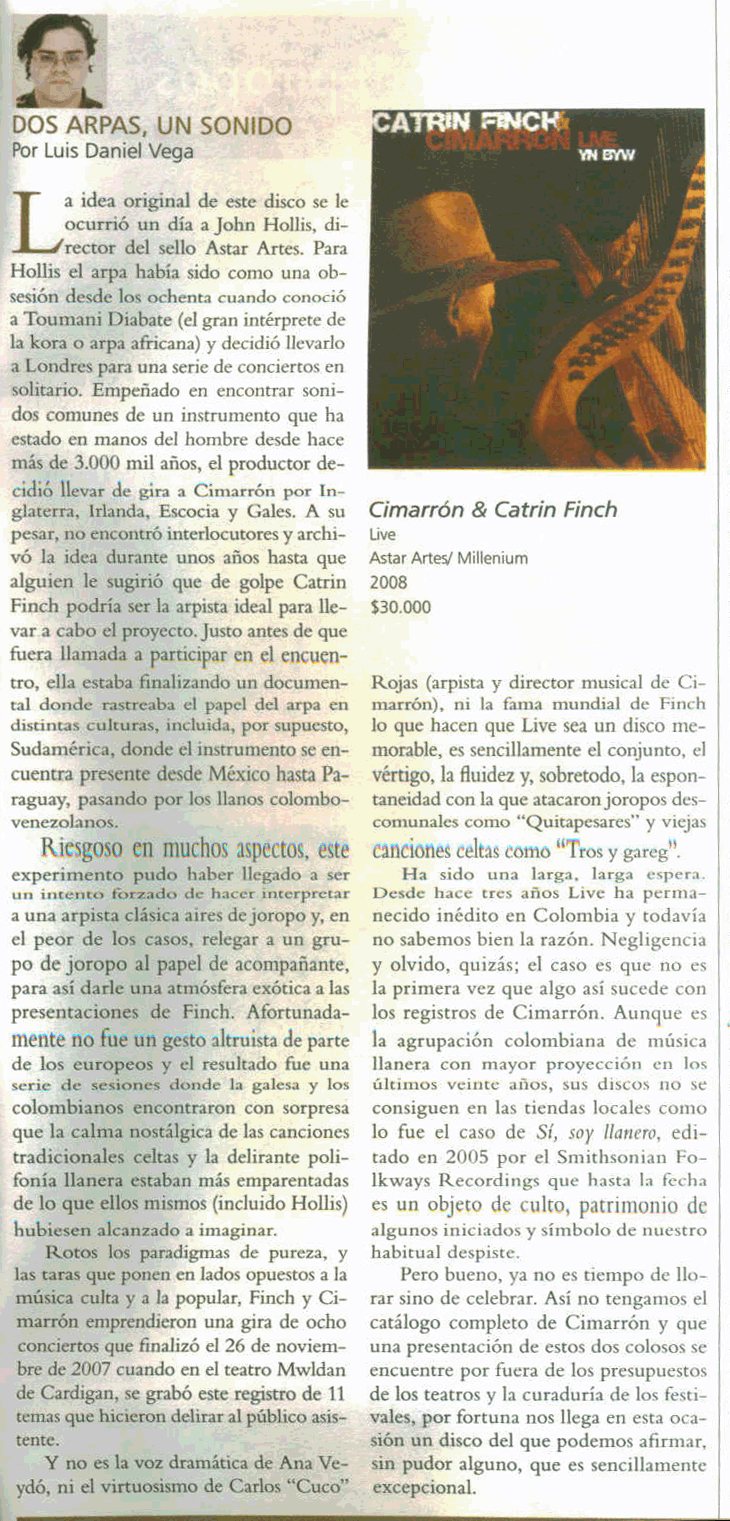
Asere Volkskrant review
Despite various changes in line up, Asere still remain one of the most interesting Cuban groups. Ever since the group originated, they aimed to play modern versions of traditional styles, like “son”. Also pop, jazz and other genres have been incorporated – on the latest album of this septet you can even hear a hint of reggae.Familiar elements have stayed, like the clavé, 3/4 – 4/4 measure changes (often indicated by those sticks), and the question- and answergame between singer and group. Left out is the machismo, leaning on clichés of the old ‘septeto’s – even though there are tributes to heroes of the past like Henry Fiol and Beny Moré. Added are beautiful, creative lines for bass, piano and drum, and elaborated refined vocal harmonies – which pays off in a rich mix of sounds. Their musical leader is Michel Padrón. He excels in the instrumental pieces in dialogue with the flexible, flamenco-like guitarplay of Andres Valdés and the crying violin of Alexis Lefevre. This diverse album is a delight for everyone who thinks Cuban music ends with the Buena Vista Social Club.
Froots Junio Groove Review
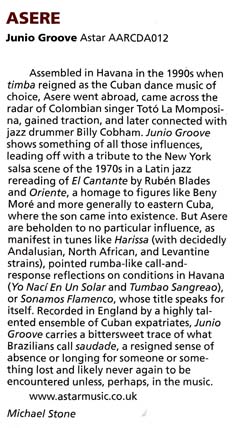
Bodega RootsWorld review
 The somber horns, meandering guitar and tentative drums at the outset of this CD soon shift gears and burst into lively celebration, and once the voice of Totó La Momposina is in the thick of the chorus, all of Colombia's African, indigenous and European roots are joyously entwined. Toto's been the leading lady of Colombian music for some time, always drawing upon traditional sources while maintaining a progressive spirit and vision that has produced such albums as 2001's stunning Pacanto, which was propelled by a contemporary African undercurrent that enriched the music magnificently. La Bodega doesn't quite match the heights of that classic though it similarly builds on a folkloric foundation of drums and vocal blueprints handed down from generations of village cantadoras who lead people in song and often serve as herbal healers as well. Fitting, given the medicinal quality of the music here. Totó La Momposina's lusty singing is nudged to full-blooded heights by an accompaniment of hand drums, small percussion, gaita flutes made from cactus wood, brass, strings and a chorus that shouts approval of her declarations at every turn.
The somber horns, meandering guitar and tentative drums at the outset of this CD soon shift gears and burst into lively celebration, and once the voice of Totó La Momposina is in the thick of the chorus, all of Colombia's African, indigenous and European roots are joyously entwined. Toto's been the leading lady of Colombian music for some time, always drawing upon traditional sources while maintaining a progressive spirit and vision that has produced such albums as 2001's stunning Pacanto, which was propelled by a contemporary African undercurrent that enriched the music magnificently. La Bodega doesn't quite match the heights of that classic though it similarly builds on a folkloric foundation of drums and vocal blueprints handed down from generations of village cantadoras who lead people in song and often serve as herbal healers as well. Fitting, given the medicinal quality of the music here. Totó La Momposina's lusty singing is nudged to full-blooded heights by an accompaniment of hand drums, small percussion, gaita flutes made from cactus wood, brass, strings and a chorus that shouts approval of her declarations at every turn.
An occasional addition of violin, marimba or accordion veers the sound toward such popular Colombian styles as vallenato and the concluding "Fiesta Vieja" winds up the disc on a distinctly cumbia note. Still, a mainly rural sound, not an urban one, guides La Bodega. The album's centerpiece, inspired by the late Colombian master drummer Batata, thunderously demonstrates as much: "Tembandumba" builds like any straight-from-Africa invocation of the Yoruba pantheon, re-connecting Totó La Momposina's homeland to the other side of the Atlantic and resounding with the kind of inspiration heard throughout. This is Afro-Colombian music at its best. - Tom Orr
Bodega Feminist Review
Opening with a brassy, but sentimental horn sound on “Manita Uribe,” the first track of La Bodega bursts into a rhythmic and exuberant potpourri of singing, guitar, and percussion accompanied throughout by a horn section that complements and leavens the sheer joy that comes through on this song. While listening to this album, I was momentarily transported from the wintry Illinois landscape to more tropical climes. The second track, “Margarita,” features Andean/Indian gaita flutes as a backdrop to the chorus and rhythmic drumming that seem to beckon one into a celebratory mood.
If you’re looking for a mood altering experience from your music, La Bodega is just the ticket. Although Totó la Momposina is from Columbia, the third track “Sueño Españo” reminded me of a band you might hear in a Mexican restaurant that stops by your table to serenade you and your dining partner. In “Fidelina,” a strong drum accompaniment is the backdrop for Totó’s strong and feisty singing along with the ever-present brass accompaniment. This is foot tapping, rousing music and reminds us that we’re meant to participate fully in life, not just be passive observers.
La Bodega has been described as “mixed indigenous Columbian and Afro-Latin.” The genre may be less familiar and accessible to listeners than the more familiar urban Latin pop sound that has garnered a worldwide following in the past few decades, but it creates a unique listening experience.
Totó la Momposina is one of the best known singers of this genre. She is a fourth-generation musician from the village of Tallaigua, which is located on the island of Momos, the inspiration for her name. La Bodega would make a great backdrop for a dinner party or any kind of social gathering where you want to lighten the mood and provide a festive and relaxing atmosphere for your guests. If you’re not the party giving type, but have a passion and interest for diverse musical traditions, this is an album that you will want to add to your collection.
Review by Gita Tewari
Junio Groove review on The Arts Desk
From
Asere Junio Groove (Astar Records)
By Sue Steward
A clutch of neo-retro son bands - including Asere – thrived during the Buena Vista phenomenon, and rose from Havana’s tourist bars and street parties to globe-trotting tours of Europe. But with the waning of BV, a reinvention away from the aged classics was vital; Asere kept hold of the early 20th-century son style (preserved in Oriente’s correctly trumpet-led version), avoided the spread of electronic Reggaeton, and dug themselves into the countryside of Andalucia, dripping flamenco into their songs in an easy, historically logical liason. "Harissa" (the North African hot sauce equivalent to salsa) goes furthest into that fusion with the lead singer David Echevarria’s tone sharper-than-son sweetness but mild compared to flamenco’s uncontrolled passion; the guitar’s note-bending is unmistakeably oud-like.
Voices are focal here and led by Echevarria and Vicente P Arencibia. Of the nine songs, "El Cantante" (the Singer) causes me problems. Written by salsa singer and poet-songwriter Ruben Blades, and immortalised by the late Puerto Rican salsa icon Hector Lavoe, it is a reminder that intellectual property rights should surround certain songs. There is only one Cantante. Lavoe’s rough, untrained, intuitively sublime countryman’s singing carries the history of the island’s music on every note, while David Echevarria represents the trained and too clean perfection of many young Cuban voices. However – elsewhere - the two men turn in some glorious performances. For the rumba, "Yo naci en un Solar" (I was born in a tenement), Echevarria’s chant-singing and the accompanying male choruses channel us deep into the earthy soulfulness of Afro-Cuban music, accompanied by a low-key bluesy-flamenco electric guitar and surprisingly reserved drumming.
The diversity of this collection reflects the new openness possible today in Cuba. Influence from once-taboo salsa is strong: Ruben Blades’s distinctively nasal, yearning singing style permeates several songs including "Sonamos flamenco", where it effectively merges into a backdrop of gypsy flamenco. "Psycologia" shows obvious influence, in the tremulous moments, from Miami superstar, Willie Chirino – a fact, until recently, unimaginable. These explorations are yielding unpredictable results, and here, work beautifully. Alas, the sleeve offers no information about the songs or musicians, just 11 pages of photographs and two of thanks from the band!









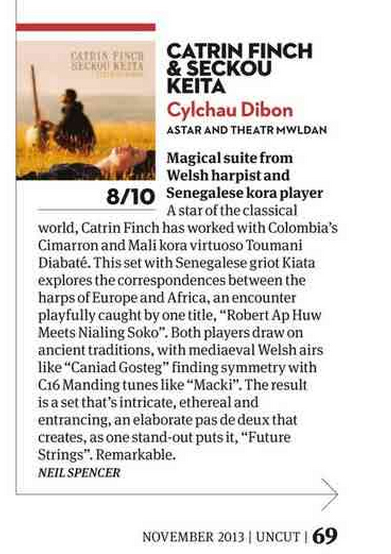
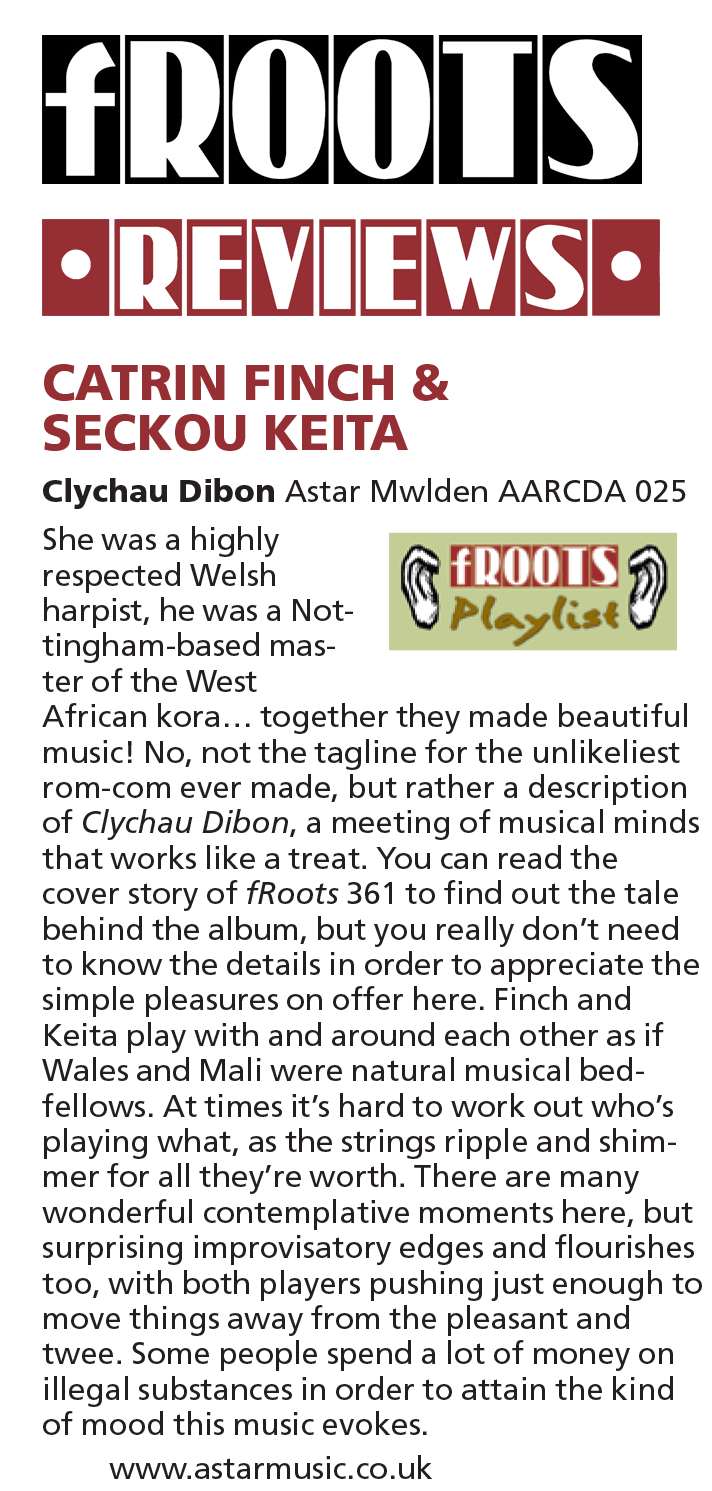
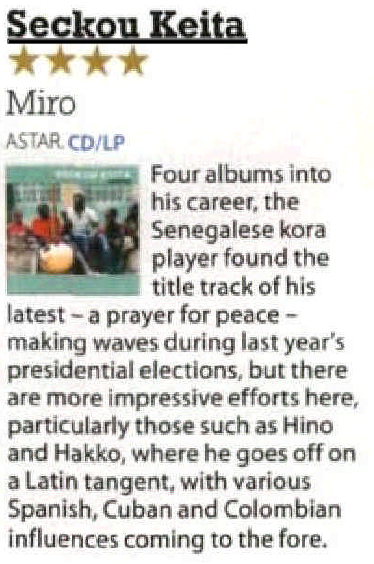 .
.
